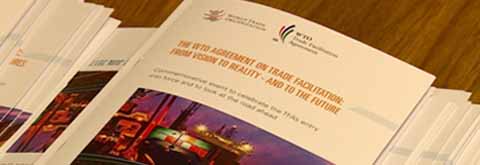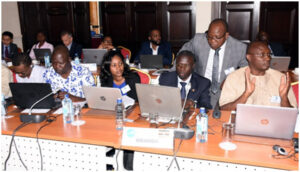The Institute has an exciting array of once-off and regular publications on key development policies, with emphasis on Sub-Saharan Africa. They include Books, African dialogue, research papers, working papers, occasional papers and economic reviews. The Institute’s publications communicate the analysis, views, and scholarship of their authors and are not intended to reflect an official view of the Institute or the views of members of the Institute’s Board of Trustees.
| Title | |
|---|---|
|
Domestic Revenue Mobilization and Reform of the Tax System in Burundi This book explores the link between tax reforms and revenue mobilization, and the options available for policy-makers on revenue mobilization in Burundi. It sets the current system in the context of reforms that have taken place over the last 30 years or so.
|
|
|
Domestic Revenue Mobilization and Reform of the Tax System in Namibia This bookexplores the link between tax reforms and revenue mobilization, and the options available for policy-makers on revenue mobilization in Namibia.It sets the current system in the context of reforms that have taken place over the last 30 years.
|
Download |
|
Taking stock of the tax reforms in Uganda, 1950–2018: Why tax exemptions should be avoided This book traces the tax policy and administrative measures that Uganda government has since introduced and implemented over the past six decades, and explains how the country fared under these reform episodes
|
Download |
|
The rise and fall of budget support in Africa This book provides a critical appraisal of budget support in Uganda since 1998- 2018, highlighting the socio political economy factors for the rise and fall of budget support. It explains why in the past years, support for GBS has diminished significantly among major bilateral donors. While some bilateral donorsreduced their GBS operations, others (formerly dedicated
|
Download |
|
Putting money in a basket with holes: a radical rethinking of the way to finance poverty reduction in Uganda This book explores ways in which donor agencies can avoid the pitfalls of basket funding to impact the lives of the poor in Uganda.
|
Download |
|
Public Expenditure Management Effectiveness in Uganda’s Education System This paper describes how the public education expenditure management system works in Uganda. It specifically identifies the formal roles of institutions; the structure and flow of information generated by the public expenditure management system and applies them to the Education Sector in Uganda. It shows the procedures for each stage in the expenditure and budget
|
Download |
The Government of Swaziland now attaches greater importance to domestic revenue mobilization than formerlywas the case. An important triggerfor increased importance of domestic revenue has been the establishment of Swaziland Revenue Authority (SRA) in 2011 and modernisation tax collection system. This paper examines the measures that have been implemented subsequent to the creation of SWA and the progress in tax collection and concludes that the benefits of reforms are, so far, modest and limited to small categories of taxes. |
||
This report presents the major areas of research and key findings of the international research project on ‘Macroeconomic Policy Challenges of Low Income Countries’. The project aims to contribute to a better understanding of the macroeconomic problems of low income countries, and facilitate an exchange of views with academics and researchers based in developed economies, including those in the international financial community. |
||
This paper documents the tax reforms implemented in Swaziland since the 1990s and how they have contributed to revenue collection. Reformshave had a major impact on collection of indirect taxes (especially VAT) but no clear impact on receipts of direct taxes and trade taxes. Despite efforts to broaden the tax base, tax collection is still heavily concentrated on very few sources, with SACU receipts alone accounting for more than one-half of total revenue. Growth in revenue collections from direct taxes on income and profits, and indirect taxes on goods and services remain substantially too low to compensate for the loss in import tariff revenues. |
||
This paper reviews studies that attempt to measure empirically, revenue gains from tax harmonisation. Three groups of studies emerge, those that use cross-country regression, partial equilibrium analysis, and applied general-equilibrium (CGE) models—they all suggest (explicitly or implicitly) that the relationship between tax rates and tax revenues is ambiguous. In some special circumstances, there are gains that can be realized from tax harmonization, but those gains are usually modest in scope. Tax harmonization tends to disadvantage certain countries especially when the participating countries are different in size, and disparities in their initial tax structures are wide. |
||
This paper documents the typology, forms, scope, origin and magnitudes, driver and impact of illicit trade in East Africa, with particular reference to Uganda. This paper shows that intra-regional trade in EAC is substantially lower than what actually takes place in the form of trade between its neighbours. Part of the reason is illicit cross-border trade, estimated to cost about US$140 million annually in losses to revenue in Uganda and Kenya alone. The paper examines a number of cross-border trade issues including dumping and counterfeit practices, smuggling, and key factors that are partly responsible for the apparent increase in cross-border illicit trade. It finds evidence of unprecedented flow of counterfeit trade - suggesting concerted cross-border effort, including greater harmonization taxes and border procedures. |
||
This paper revisits the theoretical literature on the policy process and examines how it has informed recent trade policy development in Uganda. Drawing from in-depth interviews with120 actors from government and non-government agencies and institutions working on trade related issues, the paper maps out the entry points for different institutions, including women-ownedorganisations in the policy processes; and examines whether institutions outside government matter for trade policy in Uganda. The findings underscore significant attempts to involve several stakeholders in the policy processes, but finds that their chance to influence policies is limited. Political interests, and the country’s commitments to international agreements, determine trade policy decisions. |
||
This paper documents the developments in the WTO negotiations from Doha to present day, in the context of substantive work programme on special and differential treatment (S&D) for developing countries. From the evidence so far, no substantial progress has been made in strengthening the S&D proposals and making them more precise, effective and operational as mandated in Doha. Given that economic and social conditions vary across countries, one option would be to tailor different types of S&D measures to specific circumstances and needs of developing countries on the basis of their levels of development. |
||
Using survey data covering 30 districts in Uganda, the paper examines the structure and functioning of the agricultural market in Uganda; the role of past reforms with regard to food security; the trend in food production and consumption; market linkages; seasonality as well as recurrent crisis (shocks) that have affected the market; among other issues. With regard to market integration the Johansen test was employed, based on a vector regressive (VAR) model. The bivariate cointegration test of prices between different markets was carried out with VAR = 2. |
||
This paper documents the trade patterns and trade policy in the rice sector in the East African Community (EAC) partner states, with particular reference to Uganda. Over 40 percent of intra-regional rice trade is informal trade, in part because cross-border taxes and barriers other than duty appear excessive to traders. Moreover, the circumvention of regulations and the unilateral policies pursued by EAC partners, and exceptions complicate implementation of CET. |
||
This paper examines the current non-tariff barriers (NTBs) to trade in goods in the East African Community (EAC). It identifies inefficiencies and delays at port and customs, as well as transport delays, multiple transit fees, customs documentation, restricted axle load limits and too many weigh bridges and police road blocks, import and export inspection and certification procedures, arbitrary use of rules of origin and interpretation of standards and SPS requirements, and infrastructure constraints as major obstacles to integration of the East African community. They elevate the cost of trading across borders, and severely impair export competitiveness of the trading partners especially the landlocked EAC members. The other key non-tariff barriers highlighted in the paper are congestion of trucks at the port, bribery and corruption, business registration and licensing procedures, import and export bans various national documents and inland terminal or transit parking yards procedures and facilities, and poor flow or dissemination of policy information. |







